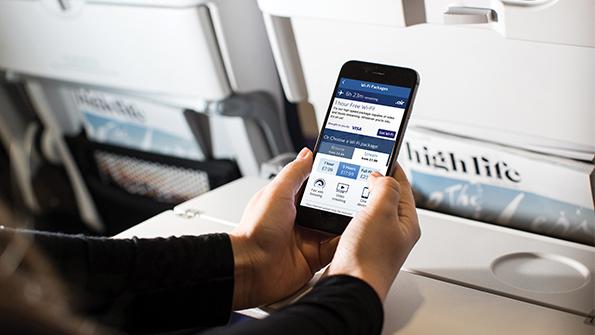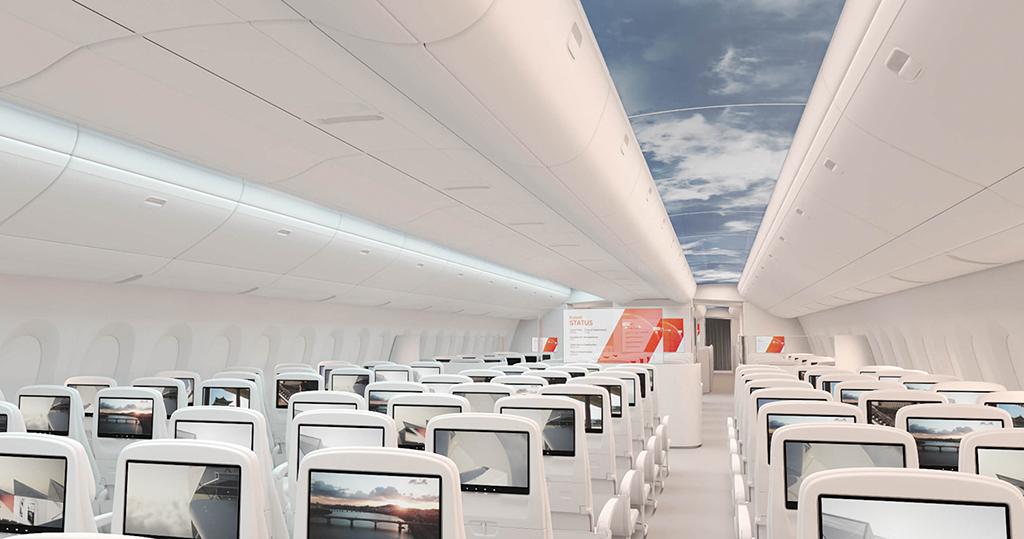
Passenger expectations of what it means to have good connectivity onboard are changing and outpacing what many airlines can provide.
Increasingly, air travelers expect not only to have access to Wi-Fi throughout their flights, but also for the service to be continuous and high quality; in other words, equal to the experience they have on the ground. And when they pay for onboard Wi-Fi that then fails, it can become a flashpoint.
“It’s vicious anger if you’re on certain flights,” Anuvu EVP, connectivity, Mike Pigott, says. Santa Ana, California-based Anuvu, formally named Global Eagle, specializes in bringing connectivity services to aircraft and ships.
Pigott says the discontent expressed when Wi-Fi fails is particularly pronounced in Europe and the US and among passengers in premium cabins, leading to negative customer feedback and poor net promotor scores for airlines.
Pigott, talking on the sidelines of the Passenger Experience Conference in Hamburg earlier this year, equated the level of frustration to a passenger having to deal with a broken seat or an IFE system that fails throughout a long-haul flight.

But another problem for airlines is that many passengers still do not even try to access onboard Wi-Fi. According to the Connected Passenger Report, a survey by communications company OneWeb, 70% of passengers have never even tried inflight Wi-Fi. OneWeb, which is building a constellation of low earth orbit (LEO) satellites to establish a high-speed communications network for both air- and ground-based customers, surveyed 4,000 passengers.
In general, airline passengers’ perception of the quality of inflight connectivity was so poor that it was not worth the hassle and/or cost. And of the remaining 30% who have tried it, close to half described the experience as frustrating.
Cost was cited by 26% of survey responders for not trying inflight Wi-Fi. Many also complained that signing up to an airline’s connectivity system was not easy. Passengers cited convoluted processes that involve creating accounts, downloading an app, getting an activation email and navigating portals. Survey respondents typically used the word “painful” to describe the connection process.
Travelers from Singapore, the UAE, UK and US were largely disdainful of airlines’ attempts to provide connectivity, with 59% of those surveyed rating the quality of onboard service as being between “very poor” and “moderate.”
Poor opinions of the service were particularly common among passengers in the 18-24-year-old group who have grown up in the digital age and expect to be able to keep in touch with colleagues, friends and family at all times. They were notably less tolerant of current standards and dismissive of Wi-Fi usability compared to older passengers, who were more accepting of moderate standards and more prepared to describe the quality of connection as “good.”
Even when Wi-Fi is provided free of charge, it often comes with “fair usage” policy restrictions, data caps, connection time limits and access to messaging or social media only, the survey noted. Nearly three in four passengers who had recently used onboard Wi-Fi reported that their use had been restricted by such limitations.
A significant part of the problem, according to the report, is that airline marketing departments have not managed expectations. Passengers see the Wi-Fi symbol at their seat and assume that the service will be the same quality that they have in their homes or workplaces.
One irritation, Pigott said, was that onboard Wi-Fi frequently comes in tiers, ranging from a free, or inexpensive, basic system perhaps only suitable for sending text messages, to a full-scale, significantly more expensive tier that allows passengers to stream content. This is an irritant because “you rarely see [tiers] in the real world,” he notes.
Technology is not keeping up with travelers’ expectations, says Jonathan Hofeller, VP, Starlink commercial sales, at spacecraft manufacturer and launch provider SpaceX. Starlink is the company’s high-speed broadband service. Travelers believe that, in five years, onboard internet will be free and frictionless. At present, people assume there will be difficulties in using it, so many simply shun it. The message to airlines, he suggests, is that they should not try to block access or put up paywalls.
NEW CONSTELLATIONS
New technologies will improve the connectivity in the next few years, AERQ’s head of strategy and business development Jonas von Kruechten believes. AERQ, a joint venture between LG Electronics and Lufthansa Technik, develops digital systems for aircraft cabins.
“New technologies like the latest LEO and MEO [medium earth orbit] constellations, as well as electronically steerable antennas, will bring many advantages to the industry: higher bandwidths, lower latency, more redundancy, better polar coverage and last but not least, less data costs,” von Kruechten says. “The new LEO and MEO constellations will not replace, but rather complement GEO [geostationary orbit] satellites as well as terrestrial/air-to-ground systems, so that you will automatically use the best available connection at any point.
“But it’s not only technology that is changing; we will also see more flexibility and choice for the airlines by the availability of standard platforms. Future connectivity products will not lock-in an airline to a specific provider anymore, but enable the airline to switch from one network/service provider to another using the same compatible hardware platform.
“Bottom line: IFC systems need to become a lot easier for airlines to adopt and use. This will require more intuitive UI/UX, simpler and straightforward contracts, and more flexible commercial models.”
The OneWeb report concludes that passengers who believe their onboard online experience is likely to be sketchy try to compensate by downloading work or leisure material to their own device before the flight, a potential stress trigger.
The company believes that the installation of its constellation of LEO satellites will improve the situation in terms of consistent, home-equivalent connectivity.
Elsewhere on the connectivity front, von Kruechten believes that, after years of predictions that passengers’ individual devices will supplant seatback screens, the traditional way of viewing content will become preeminent again.
“Seatback screens will prevail. Certain use cases are just a way better experience on a big screen, e.g., consumption of movie content,” he said.
STANDING OUT
Perhaps more significantly from airlines’ perspective, OneWeb’s report predicted that early adopter airlines that install reliable connectivity could create “a point of difference that has potential to engender positive PR and passenger loyalty.”
Currently, inflight connectivity is not a major factor in determining carrier choice. OneWeb believes that reliability has the potential to elevate the importance of inflight connectivity in passengers’ hierarchy of consideration/decision-making and could become a genuine factor in swaying passengers’ choice of airline.
“The ticket price will always remain the main driver for the passenger’s decision,” von Kruechten said. “But it’s not the absolute value of the ticket price, it’s more the price-quality ratio: the whole product package compared to the price you have to pay for that.
“And state-of-the-art cabin systems play an integral part in this product package. We will see cabin systems, including connectivity and seatback systems, remain an important differentiator between airlines, of course depending on flight length, market and airline brand positioning.
“But it’s more than that: Innovative cabin systems will enable airlines to better personalize and adapt to individual needs by using data to generate more ancillary revenues and also to save costs. Open IT platforms are the basis for that.”
The OneWeb report also found that “passengers were adamant that airlines which provide consistently high-quality IFC will stand apart from the competition and inspire loyalty.
“Airlines are likely to gain kudos for being early adopters. High-quality IFC will generate positive word of mouth. Frequent flyer passengers anticipate that in the future, high quality inflight connectivity will be a fundamental factor of consideration when they are recommending airlines.”

